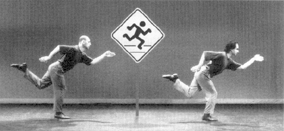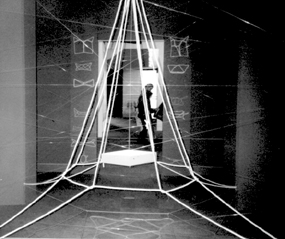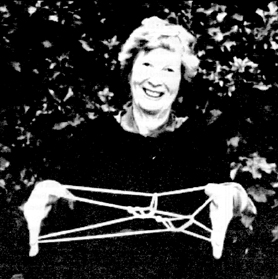
Sixth Bulletin Nears Completion
The 1999 issue of our Bulletin is nearly complete. At this point a press run in early November seems likely. By mid-December the books should be ready to mail.
Again we anticipate a large issue approaching 300 pages. This year’s issue will open with a tribute to Kathleen Haddon written by her son, Dr. Henry Rishbeth. Mike Meredith has contributed an essay on the properties of various string types. Sam Cannarozzi Yada and Tim Kennedy both offer string stories. The use of string figures in the classroom is the focus of an article by Audrey Small and Barbara O’Rand. Several small collections from Asia are featured in our Research Reports section, including figures from India (Will Wirt), Assam (A. Johnston Abraham), Burma, and Sri Lanka (Hornell). Carey C.K. Smith presents a few figures he gathered in 1980 among the Maori of New Zealand, while Dave Titus describes additional figures gathered by G.B. Gordon during his second trip to Alaska in 1907. An assortment of modern figures are featured in articles by Tetsuo Sato and Kazuo Kamiya. Three rather hefty articles complete the issue: a profusely illustrated article by George Bennet describing his arrow code for recording string figures; a speculative but well-documented article by Martin Probert on the origin of string figures, and another mind-boggling article by James Murphy on how to teach math skills using string figures (his "North American Net" system).
Again we wish to thank everyone for their patience during the lengthy editing process. While waiting for the Bulletin, members are invited to enjoy the September issue of String Figure Magazine. This issue, prepared by Joseph D’Antoni, features six novel figures: ‘Water Gourd’ from Hawaii, ‘Kiwi’ from New Zealand, ‘Finger Trick’ from Japan, ‘Howling Monkey’s Jaw’ from Guyana, ‘Bed’ from central Africa, and ‘Hull of a Ship’ from Nauru.
New Members
Since March, the ISFA has acquired twenty-one new members. However, thirty-one of our 1998 members failed to renew. We now have 178 members residing in 22 countries. Once we reach our goal of 250 members, the ISFA will become self-supporting. Please encourage others to join whenever possible.
Our new overseas members are: Kate Bunney, Albany, Australia; Briar O’Connor and Elizabeth Patterson, Auckland, New Zealand; Staffan Norrman, Sollentuna, Sweden; Elizabeth Tilling, Tyne and Wear, England; Lothar Walschik, Bremen, Germany; Claude DuPasquier, Villars-sur-glâne, Switzerland; Takuyo Uemura, Ayatown, Japan; and Alex Budzier, Newbrandenburg, Germany. From Canada we have Ellen Gray, Victoria, British Columbia. New U.S. members include: Allan Reinap, Reno, Nevada; George Bego Gerhart, Moab, Utah; Johanna McCormick, Sunnyvale, California; Crystal Brown, Boonsboro, Maryland; Cathy Traut-Hessom, Redwood Valley, California; Suzanne Courteau, Albany, California; Fred Alcantar Jr., Burbank, California; Yonah Lempert, Ithaca, New York; Audrey Kopp, Marina Del Rey, California; Dirk Elzinga, Taylorsville, Utah; and Matthew Roy, Independence, California. A big welcome to all of you!
Karl Schaffer in Scientific American
ISFA member Karl Schaffer and his math-inspired dance ensemble are the focus of Ian Stewart’s "Mathematical Recreations" column in the September issue of Scientific American. Dr. Schaffer wrote to Stewart shortly after the article entitled "Cat’s Cradle Calculus Challenge" appeared in the December 1997 issue. In his letter, Schaffer described how his innovative dance ensemble, based in Santa Cruz, California, uses huge geometric string figures to help kids visualize math concepts. Illustrations showing how two dancers form a tetrahedron appear in the article.

Karl Schaffer, co-founder Erik Stern, and puzzle-master Scott Kim began incorporating string figures into their dance routines in 1994 after meeting ISFA member Greg Keith. What evolved was a 50-minute performance called Through the Loop in Search of a Perfect Square, billed as "a show for elementary schools that tells the story of three characters on a journey of mathematical discovery, featuring giant string figures and giant tangrams." Since its inception the show has been performed hundreds of times throughout Northern California and the West.
Schaffer and Stern formed their choreographic partnership in 1985. Kim joined them in 1992. Schaffer began dancing in Birmingham, Alabama, with Southern Danceworks, and has mastered many styles including Flamenco, Bharatya Natyam, tap, and Tai Chi Chuan. He is also the recipient of a Ph.D. in Mathematics from the University of California, Santa Cruz, and teaches math when not dancing. Stern, a professional choreographer, earned a Bachelor’s degree in Biology and later a Master of Fine Arts degree from Cal Arts. Scott Kim is a well-known puzzle master, graphic artist, and designer of educational software. His puzzle designs can be found in toy stores nationwide, and he’s currently the author of the puzzle column in Discover magazine. He received a B.A. in Music and a Ph.D. in Computers and Graphic Design from Stanford University. The ensemble is the recipient of numerous awards, including a grant from the National Endowment for the Arts. Their performance schedule and other information is posted on the web at: (www.scottkim.com/dance).
New Zealand String Figure Exhibit
Late last year ISFA member Carey C.K. Smith sent photos of an impressive exhibit he visited at the new Te Papa museum in Wellington, New Zealand. The exhibit featured fluorescent string figures illuminated by black lights, video clips of Maori string figures being made (film footage from 1920), and an eight-foot tall replica of Whare Kehua -- a traditional Maori figure that resembles the Eiffel Tower.

The exhibit was created by Maureen Lander, also a member of the ISFA. Lander, who holds a Bachelor of Fine Arts degree in Photography and a Masters in Sculpture, is fascinated by new media, including light-sensitive finishes and moving images. String Games is her most dynamic installation to date. It was installed in early 1998 for the opening of Te Papa (formerly, the Dominion Museum). Dual heritage plays an important role in her work (Maureen is half Maori). Much of her art is connected to craft traditions, especially those that employ natural fibers derived from flax. She is best known for her large, mixed-media installations in which sculpture, fiber, light, and space are combined.
Her latest installation, Digital String Games, was created for the Ninth International Symposium of the Electronic Arts, held last year in Liverpool, England. In this exhibit, Lander and co-creator John Fairclough explored parallels between string games, one of the earliest forms of moving image, and interactive digital games, so popular among today’s youth. Responding to instructions from a custom user interface, a computer generated images of string figures in real time, which it then projected.
In addition to art degrees, Maureen holds a Bachelor’s degree in Maori Studies. She lectures on material culture in the Maori Studies Department at the University of Auckland. As some of you may recall, the department sponsored a web site on Maori string figures several years ago that featured old photos collected by Andersen, illustrated instructions for making traditional designs, and sound clips of Maori chants.
Next stop Aya Town
The latest addition to the ISFA member list is actually a town -- Aya, located in the Miyazaki Prefecture of Kyushu, Japan. Last month the town's tourist commissioner contacted Tetsuo Sato (our spokesman in Japan) requesting membership. In Japanese, the word for string figure begins with 'aya' (ayatori, or more precisely, aya ito tori, meaning 'woof pattern string-taking'). The commissioner wants to use string figures to promote the town's image as an innovative, multicultural center for business, recreation, and the arts.
Participants in our e-mail discussion group may recall a posting by Sato about a bridge called Ayatori-Hashi (String Figure Bridge), near Yamanaka Hotsprings in the Ishikawa Prefecture. Unfortunately the bridge is not located in Aya-town, but Aya-town does have its own suspension bridge -- a very impressive one measuring 250 meters in length. A picture of it is posted on the web at:
www.miyazaki-nw.or.jp/ayatown/eindex.html
It's nice to know that we now have an entire town that supports our efforts to promote string figures. Perhaps the ISFA should hold their next international gathering there!
Odds and Ends
Honor Maude, the world’s foremost authority on Pacific Island string figures, celebrated her 94th birthday on July 10. To commemorate the occasion, the ISFA sent her a Lifetime Achievement Award certificate with an inscription reading "for meritorious service in the gathering of string figures." A drawing of ‘Administration Staffs’ from Nauru adorned the certificate. Honor was thrilled.

Mark Sherman spent much of the summer mounting Nauru string figures for the artist working on the second edition of Honor Maude’s "The String Figures of Nauru Island." In addition to the 120 figures described in her book, he also mounted the 35 "unsolved" Jayne/Garsia figures that ISFA members managed to reconstruct over the years. To weave the intricate figures Sherman selected a very thin, slippery, string: one with properties resembling the hair string used by Nauruans. String used for making fringe on costumes proved to be ideal. The finished patterns were taped to large sheets of black construction paper and shipped to Fiji for eventual display at the University of the South Pacific and perhaps Nauru.
Two of our overseas members were busy this summer translating our web pages (posted at www.isfa.org). Myriam Namolaru kindly provided a French translation, while Alex Budzier supplied us with a German translation. We still lack a Spanish translation (Japanese would be nice too!). We are hoping that the translations will attract more non- English speaking enthusiasts.
Dr. Tom Storer spent much of his summer updating his monumental String Figure Bibliography -- a task that has kept him busy for over 30 years now. The first edition appeared in our Bulletin way back in 1985. In 1996, ISFA Press published a second edition. Plans for publishing a third edition are now being finalized. The third edition will include several hundred new entries. All members are encouraged to send photocopies of new items, no matter how small or trivial, to Tom Storer, Math Department, University of Michigan, Ann Arbor, Michigan 48109, USA. Don’t forget to include the author, article or book title, journal or magazine title (if applicable), page numbers, and publisher (company’s name and location).
Dave Titus returned to Nepal during the month of May, where he visited a leper colony in the remote western part of the country and taught string figures. During his six-week visit Dave distributed over 4000 colored loops of string! Upon his return he visited a camp in New York for inner city children with AIDS. He also stopped by the University Museum in Philadelphia to dig through their archives. His efforts were richly rewarded: in addition to the twenty figures published in our third Bulletin, Dave discovered that G.B. Gordon collected an additional fifty-five figures during his visit to Alaska in 1905, all of which he mounted on cards. Look for these in a future Bulletin.
Member Profile
The following biography of Audrey Small was written by columnist Ann Doro. It first appeared in the January 1999 issue of Senior Lifestyle, Oroville, California.

As a child in England, Audrey Small learned ‘Tallow Dips,’ a series of string figures based on an old British folk tale of a man who stole tallow dips from the market and was arrested for this minor offense. Tallow dips are wicks dipped in melted animal fat. Her mother taught Audrey several string figures and thus was born Audrey’s continuing fascination with telling stories or poems while accompanying them with string figures. Over a ten-year period, Audrey’s mother, Paula Collinson, studied folklore and string figures, guided by her father, Professor W.E. Collinson of the University of Liverpool. She entertained at clubs, schools, and library societies.
It is only natural for Audrey to hold an audience spellbound with her magical strings. "I remember when my mother said, ‘You’re on your own now. I’ve taught you some of the basics. You can learn much more from books.’" Thus Audrey began a lifetime devotion to keeping alive the tradition of accompanying story with strings that seem to talk.
In 1939, Audrey took a subsidiary high school certificate (the equivalent of a high school diploma) and planned to enroll in the University of Liverpool in the Fall. She might have gone through with her initial plan, but World War II intervened. In July of that year, Audrey accompanied her mother on a visit to relatives in New York and Chicago. They also attended the New York World’s Fair, as well as the Pan-Pacific Exposition in San Francisco.
During this visit in the U.S., they received a wire from Professor Collinson, advising that since the Germans had been torpedoing ships in the North Atlantic, it would not be safe for them to return. It was considered unsafe for German-born Mrs. Collinson to return at all during the war. Though Audrey wanted to join her friends, working in the Ambulance Corps, or in anti-aircraft activities, she accepted her fate and enrolled at the University of Chicago, living at International House near the campus. She received a B.A. in English in 1943.
While in a Shakespeare class at the University, she met Phil Small. They were married on December 11, 1942. The marriage was kept a secret. Phil had become a cadet in the Merchant Marine Academy at King’s Point on Long Island. Cadets were not allowed to be married.
Following the wedding, Audrey returned to her course work at the University, joining her husband after graduation. They lived in a one room apartment on Riverside Drive in New York City. While her husband did convoy duty, Audrey was employed by Thomas Crowell Company in New York, working on the new Roget’s Thesaurus. When the war was over in Europe, the Smalls moved west, and in 1945, Audrey worked at the U.C. Berkeley library. After V.J. Day, the Smalls decided to start their family.
When their children were grown, Audrey attended the College of Holy Names in Oakland, California, where she received a Masters in English and a secondary education credential. While in college here, she was asked to give a workshop on string figures for student teachers. In addition, she gave a demonstration at the Raskob Institute for Reading. Since that time she has been invited by a number of schools, libraries and Girl Scout organizations to present her string figures.
The Smalls are frequent International travelers. Wherever Audrey goes she shares string figures. "They are a great aid to communication, being interdisciplinary, intergenerational and multicultural," she stated. Audrey and Phil moved to Paradise, California, in 1981, where she continues to entertain and instruct at the Paradise and Chico Libraries, at schools in Chico, Oroville, and Paradise and at poetry readings where she shares her own poetry as well as many of the classics, accompanying them with string figures.
One of Audrey’s poems, first published in Blue Unicorn in 1997, is "The Caribou in the Willows."

Kathleen Haddon, author of "Artists in String" writes, "The caribou, it is said, when it became hot, stayed in the willows, but when it grew cool it went away."
String Figure Discussion Group: Summary of Topics
Since not everyone has access to e-mail and our string figure discussion group, a summary of topics posted since March is provided here. If a specific topic interests you and you would like a printed copy of the message and the responses it generated, contact ISFA Press.